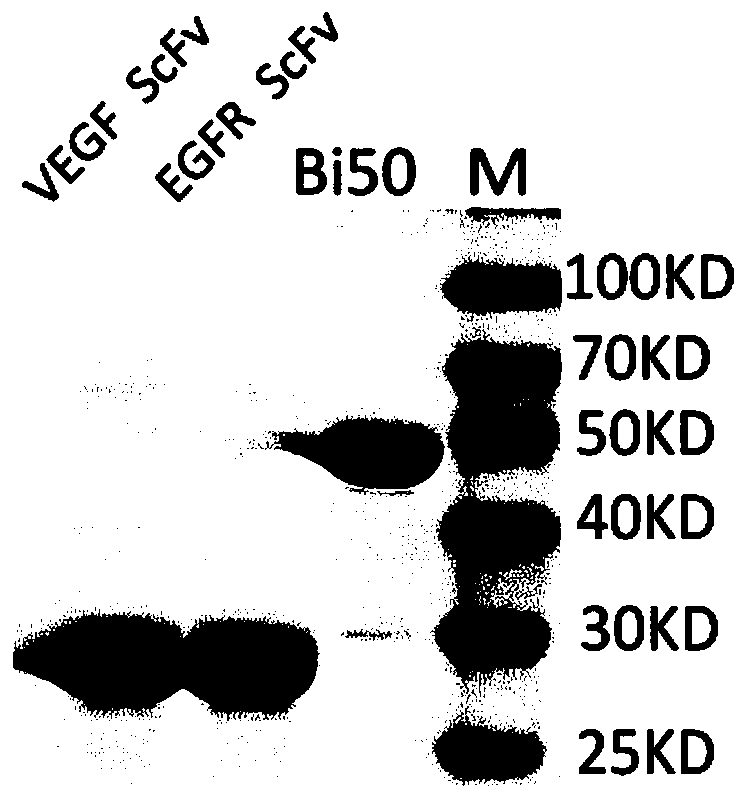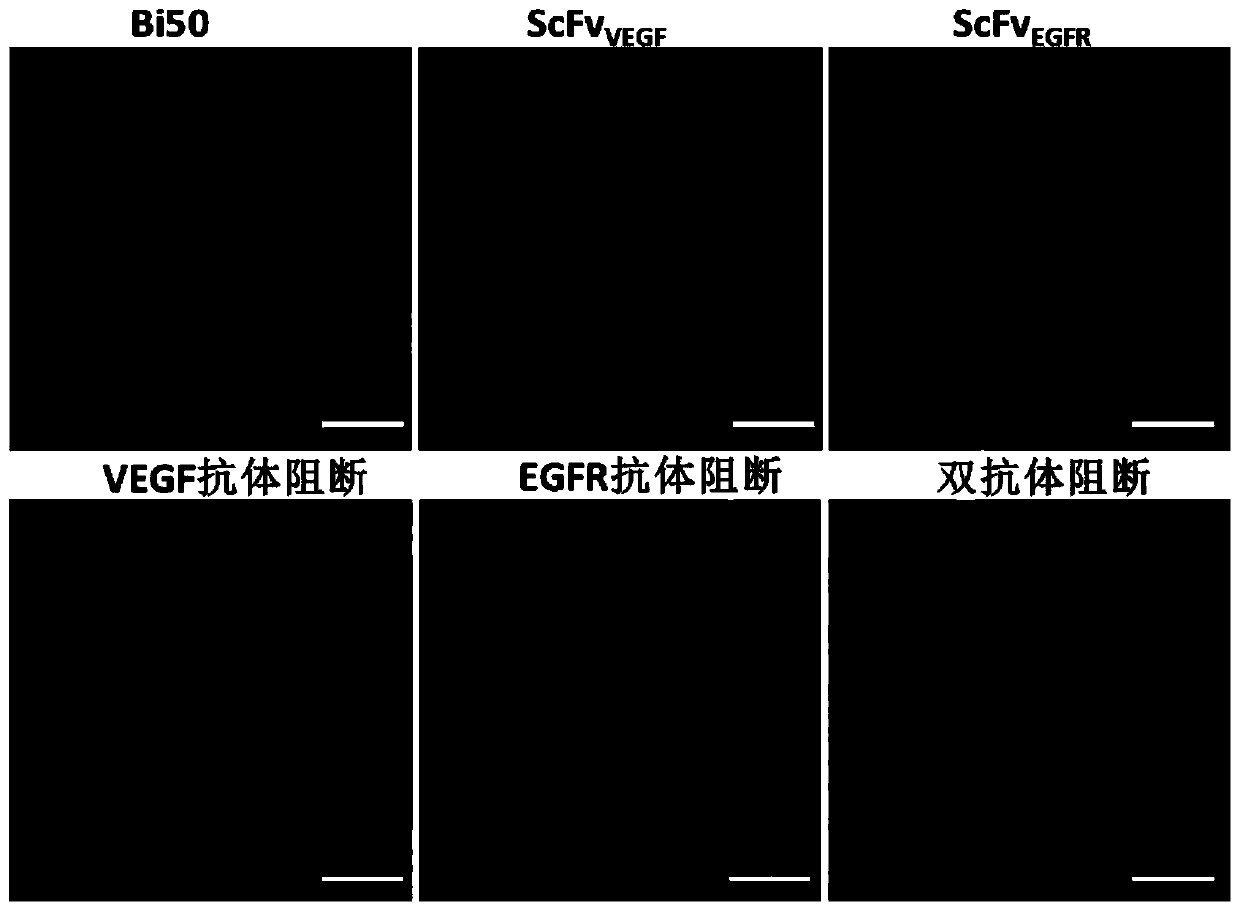Bifunctional fusion protein targeting VEGF and EGFR and application of bifunctional fusion protein
A fusion protein, dual-function technology, applied in the fields of genetic engineering and biomedicine, can solve problems such as poor curative effect, and achieve the effects of inhibiting angiogenesis or cell growth, high stability and definite curative effect.
- Summary
- Abstract
- Description
- Claims
- Application Information
AI Technical Summary
Problems solved by technology
Method used
Image
Examples
Embodiment 1
[0040] Embodiment 1 fusion protein construction and expression
[0041]Human non-immune ScFv (variable domain single-chain fragment: VH-linker-VL) antibody library constructed from healthy donor peripheral blood mononuclear cells (stock capacity: 2×10 11 ), to screen for VEGF165 and EGFR. Then with library preparation 2 x 10 13 Phage-scfv particles were incubated. After washing, three rounds of elutriation were performed. Then 2000 single clones were randomly selected, and the specific clones specifically binding to VEGF165 or EGFR were screened. Finally, clones with high optical density were selected for antibody gene sequencing. The VH CDR3 domains of these two scFvs are located at both ends of the sequence respectively. From N-terminus to C-terminus, the tandem CDRs are anti-vegf VHCDR3, CDR2, CDR1, linker, VL CDR3, CDR2, CDR1, linker, anti-egfr VL CDR1, CDR2, CDR3, linker VH CDR1, CDR2, CDR3. Synthetic bispecific ScFv genes were cloned into expression vector pET30a a...
Embodiment 2
[0043] The affinity evaluation of embodiment 2 fusion protein
[0044] Surface plasmon resonance imaging (SPRi) analysis was performed on a Plexera PlexArray HT system (Plexera LLC, Bothell, WA) using a bare gold SPRi chip (nano-gold chip with a gold layer thickness of 47.5 nm). All purified peptides were printed on the gold surface with cysteine residues sulfhydryl groups. The printed chip was then incubated overnight in a humid chamber at 4°C. The SPRi chip was washed with 5% (m / v) skimmed milk in PBS and blocked overnight before use. The SPRi analysis program was as follows: running buffer (PBST, baseline stable); sample (five concentrations of protein, bound); running buffer (PBST, wash); HO in deionized water (regeneration). 3 PO 4 The content is 0.5% (v / v). Bi50 protein was diluted with PBST to a concentration of 10μg / mL, 5μg / mL, 2.5μg / mL, 1.25μg / mL, 0.625μg / mL. Record and analyze the SPRi signal.
[0045] Experimental results show that Bi50 can not only combine ...
Embodiment 3
[0046] Example 3 Targeting effect of fusion protein Bi50 and pancreatic cancer double-positive cell Bxpc3
[0047] The human pancreatic cell line Bxpc3 cells were cultured in DMEM medium containing 100 mL / L fetal bovine serum at 1×10 5 / mL cell concentration into a round glass-bottom Petri dish at 37°C, 5% CO 2 After culturing in the cell incubator for 24 hours, the culture medium was discarded, and FITC-Bi50 (50 μg / L) dissolved in DMEM medium was added; the control group was added with the same molar concentration of ScFv-FITC dissolved in DMEM medium; After incubation for 40 min, the solutions were discarded and washed 3 times with pre-cooled PBS.
[0048] The fluorescence distribution in the cells was detected with a laser scanning confocal microscope (Olympus FV1000-IX81).
[0049] The result is as image 3 As shown, strong green fluorescence was observed in Bxpc3 cells added with Bi50, while Bxpc3 cells in the control group ScFv had only weak green fluorescence signals...
PUM
| Property | Measurement | Unit |
|---|---|---|
| molecular weight | aaaaa | aaaaa |
Abstract
Description
Claims
Application Information
 Login to View More
Login to View More - R&D
- Intellectual Property
- Life Sciences
- Materials
- Tech Scout
- Unparalleled Data Quality
- Higher Quality Content
- 60% Fewer Hallucinations
Browse by: Latest US Patents, China's latest patents, Technical Efficacy Thesaurus, Application Domain, Technology Topic, Popular Technical Reports.
© 2025 PatSnap. All rights reserved.Legal|Privacy policy|Modern Slavery Act Transparency Statement|Sitemap|About US| Contact US: help@patsnap.com



